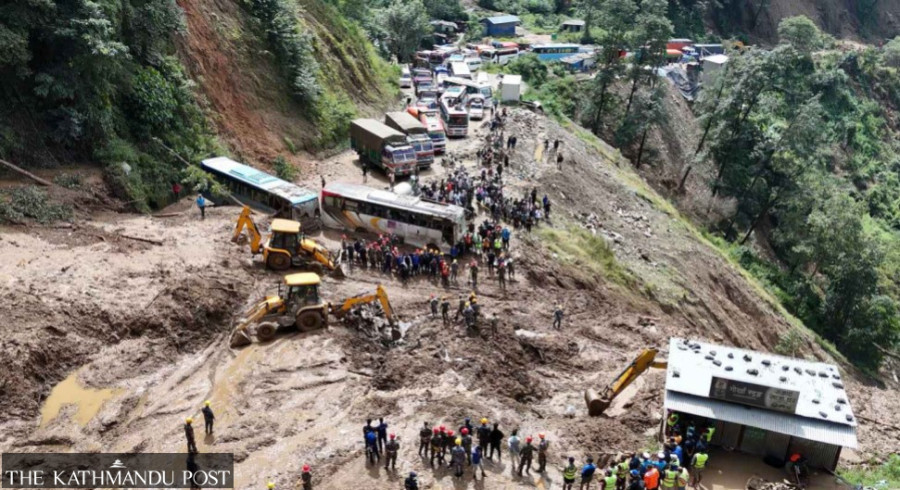Editorial
Repair the roads
The least the government can do is patch up highways quickly and ensure all get to celebrate the festivals.
The record-breaking recent rains, which have so far claimed 217 lives and left dozens missing nationwide, have badly disrupted major highways out of Kathmandu just days ahead of the Dashain holidays. At different points on several of these routes, the Nepal Army, the Armed Police Force, the Nepal Police, other agencies and local people are relentlessly working to clear the debris. But by and large authorities do not appear serious about ensuring safe and accessible travel during the Dashain travel rush.
Every year, during Dashain and Tihar, a big mass of people leave Kathmandu to travel to their home districts. Last year, around 1.5 million people did, according to the Nepal Transport Entrepreneurs Association. The Dashain travel is an ordeal for Nepalis every year due to the bad road conditions, traffic jams and the competition to buy tickets on time at a reasonable price.
However, road disruptions this time have already made the people wary of travelling. Among the routes linking Kathmandu with various parts of Nepal, Prithivi Highway is currently the only functioning one. According to the Department of Roads, BP Highway linking eastern Nepal with Kathmandu Valley is obstructed at Nepalthok, Kavre. Similarly, Kanti Rajpath, the alternative highway connecting Kathmandu to the Tarai regions and the Araniko Highway, have also been disrupted at various places. Moreover, other roads in the hilly regions are not fit for operation.
Even in the case of Prithivi Highway, the route is still risky as only one-way traffic has been open along the Jhyaple Khola and Jawang Khola sections. Although more routes might be accessible in the coming days as the Department plans diversion roads for Dashain travel, this would only mean longer travel times and more risks as rainfall in the coming days could disturb the fragile roads.
Roads are the major means of travel for Nepalis, especially during the festivals when air ticket prices soar and become unaffordable for many. On Saturday, after the disaster struck several parts of Nepal, there was a hike in air ticket prices. People fretted online about how the Kathmandu-New Delhi flight was cheaper than the Kathmandu-Dhangadhi flight. Prime Minister KP Sharma Oli appealed to the domestic airlines to maintain regular ticket prices or offer discounts. The airline companies did agree to reduce the price for three days following public outcry. On Tuesday, the companies further agreed to continue this until the roadways become operational again. Whatever the airline companies do or don’t do, the government cannot overlook the conditions of the country’s major highways as far too many Nepalis simply have no financial means to fly. Dashain places a heavy financial burden on the average Nepali, especially with the rising prices of goods. The floods and landslides are already translating into hikes in the price of day-to-day necessities.
Given the sorry condition of the highways, people are deciding not to travel to their home districts. Moreover, the Federation of Nepali National Transport Entrepreneurs closed advance bus ticket booking for Dashain on Tuesday. This seems reasonable. However, the authorities must be vigilant about transporters using this tactic to cram in passengers at the last moment. The government must mobilise all its resources to repair the damaged highways. Nepalis of late have not had much to celebrate. Continuous political instability, rising prices and natural disasters have been frequent downers. The least the government can do now is to repair the highways on a war footing and ensure that people of all economic backgrounds get to celebrate the festivals with their loved ones.




 18.12°C Kathmandu
18.12°C Kathmandu












%20(1).jpg&w=300&height=200)

